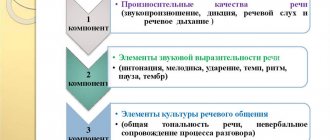Concept and features of dialogic speech
The main communicative forms at any age are monologue and dialogic speech. The latter is the most common and productive. In conversation, new ideas are born, plans are made, actions are coordinated.
For young interlocutors, their dialogues are no less important than the communications of adults. Children's conversations, especially in early preschool age, do not have informative and verbal content. The main thing is that they help establish contact.
Preschoolers are still developing conversation skills, but the main features of dialogic speech can already be seen in their communication.
- Motivation. A person who starts a conversation always has a reason for speaking. It is important that the interlocutor also has the desire to continue the conversation. Dialogue is possible if both are interested in the subject of conversation. Children can enthusiastically discuss a new toy or an invented game, but if one of the kids does not feel interested, he will become silent or move away.
- Availability of targeting. The key characteristic that distinguishes this form from the monologue. The speaker turns to the interlocutor, tells him that his parents bought a hamster, or his dad brought a new set with robots.
- Emotional coloring. In addition to words, dialogical speech contains expressions of emotions: sadness, joy, surprise, resentment. To do this, not only words are used, but also intonations that help the interlocutor recognize the mood of the second person.
- Situational. The first phrase does not come out of a vacuum. It is the current circumstances around that prompt a child or adult to raise a certain topic.
- Reactivity. A characteristic that determines the direction of a conversation. Two people participate in a dialogue, and the reaction of the second can take the conversation in a different direction, provide food for new thoughts and statements, and motivate action. For example, a message about a hamster can transform into a discussion or coming up with a name for it, or a debate about which pet is better.
The importance of dialogue in communication
The word “dialogue” is translated from Greek as “conversation.” That is, this is a form of communication that involves the exchange of remarks. They have a certain linguistic composition, which is formed against the background of the perception of someone else's speech.
Some scientists believe that dialogue is not just a form of speech, but one of the types of human behavior. In order to use it to communicate and interact with people, the child must master a whole set of speech and social skills, which he masters gradually.
During a dialogue, people usually exchange opinions and thoughts, each subsequent remark depends on the previous statements of the interlocutors. It should be noted that this process occurs without preliminary thinking and the formation of a conscious statement.
Usually all dialogues are short.
Dialogue speech as the main means of communication of preschool children
For preschoolers, conversational speech is the foundation for the formation of other forms, for example, monologue. The development of dialogic speech in preschool age later allows older children to speak coherently.
In addition, communication provides knowledge of native speech, expansion of vocabulary and understanding of the meaning of words, learning the minimum rules of etiquette necessary during conversation.
Situational dialogues of younger preschoolers
In early preschool age, speech is developed enough to speak in short phrases, but the skill of interactive communication is just beginning to develop. Most often, the development of speech in children 3-4 years old is at the stage where their dialogical speech is limited to short remarks within the framework of the situation.
In the sandbox, in kindergarten, they can “discuss” a sculpted Easter cake or toy. The beginning of a conversation is usually involuntary and provoked by the situation: whether you liked or did not like the “product of sand architecture”, the desire to play with a doll, to join forces in rolling a car.
In early preschool age, there is usually no place for embarrassment and isolation, with the exception of certain cases, so children speak willingly to each other and start a conversation without fear, although the brevity and simplicity of sentences does not make the conversation particularly informative.
For them, adults are outside their comfort zone, unless they are immediate relatives. It will be difficult for a mother’s friend who comes to visit to get the baby to talk: most often he will limit himself to a few answers and run off to play or mind his own business.
It is necessary to have significant teaching experience and skills in order to encourage a child to engage in a longer dialogue with an unfamiliar adult.
Speech dialogue activity of 5-year-old children
5 years is a period of active development of imagination, and, accordingly, the beginning of inventing games that have a plot and involve several participants. Involvement in the game is often accompanied by a “hullabaloo”: children discuss how to play, what to do next, and assign roles. During this same period, inner speech develops, that is, the ability to “think in words” before speaking them out loud.
Quiet solo games usually do not require conversation, so the peak of dialogue activity occurs during group time. However, at this age it is still difficult for five-year-olds to come to an agreement: they are excellent at forming their own statements, but are just learning the skill of listening to their interlocutor. In this case, adults sometimes need to help structure the conversation to help them come to a decision and continue the game they started.
Content of dialogues of older preschoolers
Before entering school, the child is already familiar with all the features of oral speech and its main forms, and conducts dialogue at a high level. Entering into a conversation is possible with the help of an emotional story about impressions or experiences and through the development of coherent speech.
Also, the emerging skill of asking questions helps an older preschooler initiate a conversation by asking a peer about something. In addition, the older preschooler already knows how to find words to interest a friend and encourage them to start playing together.
Basic dialogical skills of an older preschooler:
- listens to the interlocutor, demonstrating interest;
- with a high degree of interest, listens to phrases to the end;
- reasons and uses arguments to support a point of view;
- gives short or detailed answers depending on the situation;
- formulates and asks questions correctly.
However, during the game, these skills can be forgotten under the influence of inspiration and involvement. The sequence of replicas may be lost. The child is able to jump from topic to topic, interrupt the interlocutor, trying to quickly express his own thought or idea.
With the systematic development of dialogic speech in children of senior preschool age, by the time they enter first grade, the skill will be distinguished by the following features:
- a universal means of communication that does not require situationality;
- high level of expressiveness of intonations;
- the use of words that enrich the emotionality of the narrative;
- thoughts are formulated coherently and consistently;
- dialogue can take place in various forms: story, conversation, reasoning, listening.
Speech requirements for kindergarten teachers
High demands are placed on the speech of preschool teachers. The teacher must not only correctly express his thoughts and follow literary norms, but also be able to build a dialogue in accordance with the level of development of the students. Basic requirements that an employee’s oral speech must meet:
- Right. Following the norms of the language.
- Accuracy. Using words in the correct meaning.
- Logic. Proper use of intratextual communication.
- Purity. Absence of non-literary words and expressions.
- Expressiveness. Mastery of intonation, pitch, strength and volume of voice to attract students' attention.
- Wealth. Imagery of speech, wide vocabulary.
- Relevance. Correspondence of speech style to the current situation.
If there are deviations from the listed requirements, the teacher should improve his speech through self-education or advanced training. To eliminate errors, presentations for teaching councils are also used, containing control tests and instructions for educators.
Why is the purity of speech of a preschool teacher important?
In the book “Methods for the development of speech and teaching the native language of preschoolers,” the author M. M. Alekseeva emphasizes that a child learns spoken language through imitation of adults. He adopts not only grammar, but also individual words and errors. If the speech of a teacher of a preschool educational institution contains filler words, violations of grammatical or phonetic norms, this will negatively affect the speech development of preschool children.
What is the purity of speech of a preschool teacher? In the absence of slang and dialect expressions, as well as filler words (well, in short, that means, in general).
Note! Educators can test themselves for compliance with these requirements using specially developed teaching aids.
The leading publications are those edited by V.V. Gerbova, which are included in the educational complex “Preschool Education Program. From birth to school." The material complies with the Federal State Educational Standard. The manuals will be useful not only for educators, but also for parents of preschool children. To better assimilate information, it is recommended to take notes.
Speech development in preschool educational institutions needs to be given maximum attention. The overall mental growth of a preschooler depends on the correctness of the learning process. According to the recommendations of psychologists, you need to master basic conversation skills at home, with your parents or nanny. You should not hope that a preschooler will learn communication skills without the help of adults.
Conditions for the development of coherent dialogical speech in preschoolers
Based on realities, we can say with confidence that almost all preschoolers gain experience in dialogue with peers, only it is different for everyone. This depends both on the child’s personal characteristics, on his communication abilities, and on the regularity of communication.
Moreover, a safe and motivating atmosphere is important in communication, within which the child can safely express his thoughts without fear of saying the wrong thing or making a mistake. Unfortunately, peer society is not always willing to take into account the characteristics of withdrawn or phlegmatic children.
Introverted, uncommunicative or slow children need comfortable conditions that promote conversation. They will not be the first to enter into a conversation, and will not insert their remarks when several people are communicating. Namely, these children need the development of interactive speech.
In such cases, it helps to have the opportunity to develop speech skills not only in free communication, but also by organizing training.
Conversation as a means of developing dialogue skills
Educational conversations conducted by an adult help accelerate the development of communication skills in preschoolers. It is necessary to create appropriate conditions for the child to respond to the adult’s proposal and start talking. As a rule, several important circumstances should be taken into account:
- Place the child close to you. To do this, toys, pictures, and pets are used in a living area.
- Find the right time. The conversation will be ineffective if the child wants to play or draw.
- It is important that the environment is calm and nothing distracts from the lesson. A child needs comfort and a sense of security to talk.
- The effectiveness of classes directly depends on how well the adult knows the child: his interests, favorite games, relationships with loved ones.
- Structure the conversation so that the preschooler speaks more, feels attention and interest in his own words, but at the same time is interested in what the interlocutor is saying.
For classes, you can use preliminary reading of fairy tales and stories, which are further discussed. Also, simple instructions that require you to enter into a conversation reinforce the skill of dialogue. For example, teachers ask to show a newcomer toys in the toy library, instruct him to go to another group to get some item, or verbally convey information to parents.
Another method of forming dialogical speech: speech situations in which peers participate. The teacher offers a story, assigns roles, and on behalf of the characters, the children must discuss what happened.
As a result of such activities, children acquire skills and develop skills:
- ability to take initiative;
- ability to use various means of communication – words include facial expressions and gestures;
- the ability to maintain a dialogue without being distracted by foreign objects;
- pay attention to the words of the interlocutor and adhere to the rhythm of the remarks;
- the ability to speak kindly, calmly and without shouting.
Principles of organizing dialogue interaction
The organization of dialogue in a training session has its own specifics. First of all, it is necessary to take into account two leading principles of dialogue:
- Elimination of impact on the student. You cannot put pedagogical pressure on students. You can't just teach. The teacher himself also needs to develop in the process of communicating with students. Therefore, it is necessary to build interaction with them.
- Emphasis on independent work. The teacher should not formulate the problem or ask questions himself. He only needs to direct students to work independently: they put forward a problem and look for ways to solve it.
Only focusing on these principles allows us to put the student’s personality in a priority position.
Development of dialogic speech in role-playing game
In developing the skill of dialogical speech, the influence of role-playing games is great. This game form involves the distribution of roles and the creation of a plot, as well as adherence to the rules.
Many games involve conversational communication as a basic condition. Preschoolers repeatedly scroll through the scenes of “seller - buyer”, “appointment with the doctor”, “daughter - mother”. Dialogues in games help children quietly develop and improve the necessary skills.
A well-developed language function is the basis for productive relationships between people at any age. Kids are still learning to communicate, but older preschoolers should already have the skills to conduct a structured and informative conversation, since in the very near future their efforts will shift to school education, and dialogic speech will be used as a developed means of any interaction.
Advantages of dialogue learning technology
The use of dialogue learning technology in the educational process makes it possible to make the educational process focused on the personal development of students. In addition, it has a number of advantages:
- Ensures the focus of the educational process;
- Develops cognitive activity in students;
- Promotes the development of mental activity among dialogue participants;
- Activates the creative side of development;
- Promotes self-realization, self-development and self-improvement of the individual;
- Develops students' communication skills;
- Forms the ability to build a conversation and conduct a dialogue;
- Develops question-and-answer communication skills;
- Develops important personal qualities: tolerance, ability to listen, respect for another person, adequate perception of someone else’s point of view.






